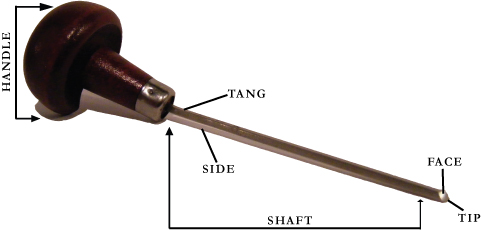Burin (engraving) on:
[Wikipedia]
[Google]
[Amazon]
 A burin ( ) is a
A burin ( ) is a
 A burin ( ) is a
A burin ( ) is a steel
Steel is an alloy made up of iron with added carbon to improve its strength and fracture resistance compared to other forms of iron. Many other elements may be present or added. Stainless steels that are corrosion- and oxidation-resistant ty ...
cutting tool used in engraving
Engraving is the practice of incising a design onto a hard, usually flat surface by cutting grooves into it with a Burin (engraving), burin. The result may be a decorated object in itself, as when silver, gold, steel, or Glass engraving, glass ...
, from the French ''burin'' (cold chisel). Its older English name and synonym is graver.
Etymology
The term ''burin'' refers to a tool used by engravers that has a thin, pointed blade and it used to etch or cut. The first known use of the word dates back to France in the mid-1600s when the term was coined for the tool we know today.Design
The burin consists of a rounded handle shaped like a mushroom, and a tempered steel shaft, coming from the handle at an angle, and ending in a very sharp cutting face. The most ubiquitous types have a square or lozenge face, a high-end repertoire has many others. A tint burin consists of a square face with teeth, to create many fine, closely spaced lines. A stipple tool allows for the creation of fine dots. A flat burin consists of a rectangular face, and is used for cutting away large portions of material at a time. The earliest uses of a burin come from the Lower Paleolithic era, the tool was created and used by early humans to engrave bone, leather, antler, wood, and other dense elements that early humans encountered. The tool comes from flint and in its creation is referred to as a 'flake'. The burin is created when the smaller flake is struck by the larger one, chipping away at the mineral and creating a sharp point. The tool was used alone or with a handle made of either animal hide or wood in later years.Uses
The malformed hand of Hendrik Goltzius, which was especially suited to the use of a burin An engraving burin is used predominantly by intaglio engravers, but also byrelief
Relief is a sculptural method in which the sculpted pieces are bonded to a solid background of the same material. The term ''relief'' is from the Latin verb ''relevo'', to raise. To create a sculpture in relief is to give the impression that the ...
printmakers in making wood engraving
Wood engraving is a printmaking technique, in which an artist works an image or ''matrix'' of images into a block of wood. Functionally a variety of woodcut, it uses relief printing, where the artist applies ink to the face of the block and ...
s. Usually an engraver will have several tools, of different sizes and shapes of cutting face.
It is held at approximately 30° to the surface. The index and middle finger guides the shaft, while the handle is cradled in the palm. The 16th-century Flemish engraver Hendrik Goltzius
Hendrick Goltzius, or Hendrik, (; ; January or February 1558 – 1 January 1617) was a German-born Dutch printmaker, draftsman, and painter. He was the leading Dutch engraver of the early Baroque period, or Northern Mannerism, lauded for his s ...
showed adept use as he found his unusually formed hand was well-suited for its cradling and guiding.
In its earliest uses the burin cut and carve bone, antler, and wood to create sketches or to cut meat or thinner materials. It was created by early humans in the Lower Paleolithic era by striking two flakes or flint together until the smaller of the two formed a point sharp enough to engrave a surface. Some art from this time period, such as sketches and pictures, can be attributed to the use of the burin as an etching or engraving tool.
Archeology
Specialist’s study what typology and technology defines a Burin as elements of the tool has been seen through history ranging from a carved prehistoric tool made of tough minerals to a modern engravers tool. A prehistoric Burin dates back to the Lower Paleolithic era and are commonly found in those digging sites. The tool in this sense was used to sharpen, cut, and chisel through bone, antler, wood, and other dense elements that early humans encountered. Mostly, the tool was used to carve images. People in the Paleolithic era society were hunter-gathers and chose locations of living that could be defended against predators and weather. The tool is created by striking the mineral flake with edge of a larger flake causing the edge to chip and become sharp and pointed. The tool can be used by itself, with an animal hide handle, or in later years a wooden handle became common.References
External links
{{Authority control Printmaking Chisels